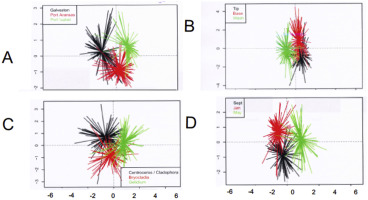
Authors
Epiphytic diatom community structure associated with selected macroalgae collected from jetties at Galveston, Port Aransas, and Port Isabel, Texas was investigated using multivariate and community statistics. Redundancy analyses revealed community variation attributable to treatment (4% in Galveston, up to 8–12% at Port Isabel and Port Aransas), to host plant (6–9%) and to season (ca 14%). Shared effects between pairs of factors were between 1 and 2% or less, indicating factors tested acted independently and significantly to vary the diatom community structure over a two year period. A coastal salinity gradient explained 16% of the variation. Host specificity was documented and correlated with season. Treatment included a wash, tip and base preparation processed to analyze metaphyton and epiphyton separately and determine zonation on hosts and within the narrow intertidal (11–25 cm). Wash assemblages were statistically different and more diverse than attached assemblages during the fall/spring but were more alike in winter when hosts were senescent. It is recommended that future studies of epiphytic communities take advantage of rinsing or washing the host plant to capture this important and significant part of the diatom community associated with macroalgae. Variation between hosts was greater than variation among host replicates, in abundance rather than identity.
